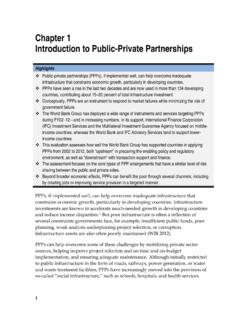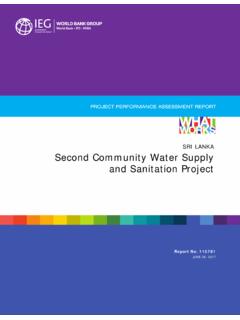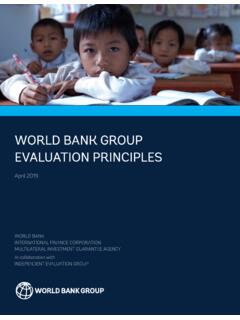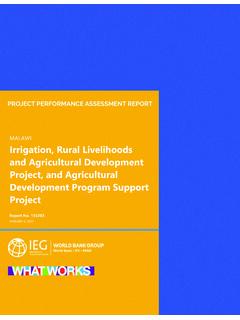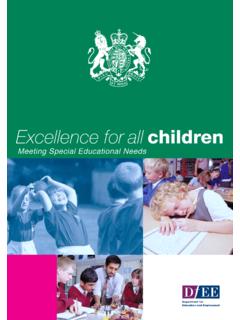Transcription of Opportunities and Challenges from Working in …
1 Opportunities and Challenges from Working in partnership : Findings from IEG s Work on partnership Programs and Trust Funds Abbreviations and Acronyms CGAP Consultative Group to Assist the Poor CGIAR Consultative Group for International Agricultural Research DRM Disaster risk management ESMAP The Energy Sector Management Program FCPF The Forest Carbon partnership Facility GEF Global Environment Facility GFDRR The Global Facility for Disaster Risk Reduction GPE The Global partnership for Education GPOBA Global Program for Output-Based Aid IBRD International Bank for Reconstruction and Development IDA International Development Association IEG Independent Evaluation Group IFAD International Fund for Agricultural Development IFC International Finance Corporation ILC International Land Coalition ILO International Labor Organization M&E Monitoring and
2 Evaluation REDD Reducing Emissions from Deforestation and Forest Degradation REDD+ REDD plus the role of conservation, sustainable management of forests and enhancement of forest carbon stocks TB Tuberculosis Director-General, Evaluation : Ms. Caroline Heider Director, Independent Evaluation Group, Country , Corporate, and Global Evaluations : Mr. Nick York Manager, : Ms. Geeta Batra Task Manager : Mr. Rasmus Heltberg i Contents iii Summary .. v 1. Background and 1 2. Partnerships Represent Opportunities .. 1 3. Partnerships create Challenges .. 4 First challenge: Why can t the program be supported with existing mechanisms? .. 4 Second challenge: How to ensure effective oversight and accountability? .. 5 Third challenge: How will this complement the Bank s country operations? .. 8 Fourth challenge: How will we know what the program has accomplished?.
3 10 4. How to ensure results from partnerships? Summary of recommendations .. 11 Boxes Box 1. Partnerships, global public goods, and trust funds: what they are and how they overlap .. 2 Box 2. Most Partnerships are hosted by one of the partner organizations .. 7 Box 3. When partnerships are operationally integrated: the Global Facility for Disaster Risk Reduction (GFDRR) .. 8 Box 4. When Partnerships diminish over time: The World Bank Group and the Global Environment Facility (GEF) .. 9 Box 5. Pushing the envelope on forest carbon .. 9 Box 6. Why are programs M&E practices so weak? .. 10 Tables Table 1. Examples of Linkages between the Bank and Four Global partnership Programs .. 15 Appendixes Appendix A. Sources .. 13 Appendix B. Linkages .. 15 References .. 17 iii Preface As part of IEG s commitment to promoting learning from evaluation experience, IEG is supplementing its main evaluation reports with a series of learning-focused notes which aim to make evaluation evidence easily accessible to key audiences.
4 This note brings together in short and accessible form findings from IEG evaluations on global and regional partnership programs and trust funds over the last 10 years, to help inform discussions on how to address the partnership agenda in the World Bank Group strategy. The note is not a full evaluation of partnership effectiveness. It focuses on the World Bank s experience in partnerships. v Summary Partnerships and trust funds are big business for the World Bank Group. It participates in around 126 global partnership programs and administers more than 1000 trust funds which have become a significant source of revenue for the Bank Group and its clients. partnership and trust funds offer Opportunities for the Bank to benefit from partners skills and resources, extend its reach, and innovate. Some programs and funds are complementary to the Bank or fill gaps, for example on global public goods.
5 IEG has found that most partnership programs tackle relevant development problems and that the Bank often makes strong contributions. But there are also risks, for example proliferation of uncoordinated or competing initiatives and high transaction costs. A key challenge facing the World Bank Group, therefore, is to make sure that its engagements in partnerships and trust funds create shared value for its client countries and support its goals of ending extreme poverty and boosting shared prosperity goals. As emphasized in the World Bank Group strategy, engaging in strong and well-aligned partnerships can help the Group enhance its contributions to global development, but the evaluation experience summarized in this note suggests that there is room to improve. IEG, in its work on partnerships and trust funds, has found four common Challenges related to selectivity, oversight, linkages to country operations, and results frameworks: Selectivity: Most donors allocate funds from a fixed envelope for total official aid; trust funds have not increased the size of that envelope.
6 As earmarked pots of money with separate approval and allocation processes, trust funds tend to increase transaction costs for client countries and for the Bank and to impose parallel budgeting and approval processes. That is why the Bank needs to be selective in what trust funds and what governing procedures it agrees to. Oversight: Evaluations have found weaknesses in governance and transparency in many partnership programs, as well as frictions and conflicts of interest from the multiplicity of roles that the Bank typically performs in partnerships. Yet The Bank has no routine oversight and tracking of partnerships and of how it engages in them. Links to country programs: The Bank is uniquely placed to help client countries benefit from global programs. However, there are often missed Opportunities at the intersection of the Bank s participation in global programs and its country engagements.
7 There are no explicit agreements on division of labor between the Bank and some major global health programs. Results are often unknown. Although there has been progress in recent years, many partnerships the IEG has reviewed lacked clear goals and indicators. It is often hard to attribute results to specific partnerships let alone assess results across the portfolio. IEG has recommended reforms (summarized at the end of this note) to help the Bank address these Challenges via internal reforms to ensure selectivity, routine corporate oversight, and vi policies and standards around partnership governance, engagement strategies for individual programs, empowerment of staff serving on partnership boards, and results frameworks. 1 1. Background and Context The rise of many global partnership programs during the last 15 years has transformed the international aid and development landscape.
8 Partnerships feature prominently in the new World Bank Group strategy, which recognizes that meeting the World Bank Group goals demands deepening partnerships that bring together resources, expertise, and ideas from actors across the development spectrum .1 The strategy notes the rise in demand for World Bank Group services on behalf of global partners (sovereign countries, foundations, the private sector), as witnessed by the growth in trust fund, innovative finance, and financial intermediation business. It calls for an expanded World Bank Group role in global and regional engagements that complement its country-led business model. Yet it is not always clear how well World Bank Group global engagements support its poverty and shared prosperity goals. The Bank Group strategy notes that global engagements represent an important opportunity for the World Bank Group to make an impact on development, but this rapidly growing role also places additional demands on the World Bank Group that it must ensure are aligned with the goals.
9 How does the organization oversee whether the World Bank Group partners effectively when it chooses to engage with partners? How does it exploit the fact that The Bank sits on the boards of more partnership programs than any other development organization (around 91).2 How does it make sure that trust funds support rather than distract from the mission? The strategy prominently highlights the need to ensure better management, oversight, and selectivity in World Bank Group partnerships and promises to manage global engagements as business lines with policies for budgeting, cost recovery, and results The ongoing change process offers Opportunities to deliver on the promise of the strategy, for example as part of the integration of partnerships and trust funds into the Global Practices. IEG has reviewed more than 23 global partnership programs, as well as the Bank s approach to the trust funds that finance such These reviews have found that most partnership programs tackle relevant problems--often making solid contributions to development yet confront a pattern of similar weaknesses leading to missed Opportunities and compromised effectiveness.
10 There are four common Challenges related to selectivity, oversight, linkages to country operations, and results frameworks. IEG has recommended reforms to help the Bank address these Challenges . This learning-oriented note summarizes IEG s findings and recommendations. The hope is that better navigating the predictable Challenges confronted by partnership programs will help make programs, and the Bank s role in them, more effective and deliver results to clients. We begin by looking at the Opportunities that partnerships represent before drilling down on the four common Challenges . 2. Partnerships Represent Opportunities Collaborating in a partnership is an opportunity to achieve more than what each partner might accomplish on its own. Partnerships are also a major source of fundraising for the 2 Bank Group. As collaborative ventures, partnerships are distinct from trust fund which are vehicles for channeling finance.
